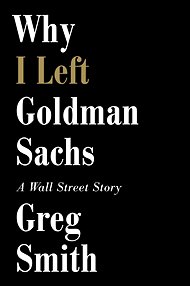 Greg Smith’s memoir is set for publication on Oct. 22.
Greg Smith’s memoir is set for publication on Oct. 22.
Wall Street has plenty of worries heading into autumn, including the stability of the euro zone, persistent United States unemployment and the historically volatile October stock market.
Goldman Sachs has an additional concern: Greg Smith’s book.
Mr. Smith’s memoir, “Why I Left Goldman Sachs,” is set for publication on Oct. 22. The release date comes just seven months after Mr. Smith publicly resigned from the bank with an opinion article in The New York Times detailing his disappointment with Goldman’s business practices that reflected, more broadly, a corrosive culture at the nation’s largest banks.
 Herman EstevezGreg Smith’s book advance was close to $1.5 million, according to people with direct knowledge of the negotiations.
Herman EstevezGreg Smith’s book advance was close to $1.5 million, according to people with direct knowledge of the negotiations.
The article struck a nerve. Within 24 hours, it had more than three million views online. Publishers clamored for the rights to a book. Grand Central Publishing, a division of the Hachette Book Group, secured a deal, offering Mr. Smith an advance of close to $1.5 million, according to people with direct knowledge of the negotiations.
Mr. Smith’s book comes at an inopportune moment for Goldman, which has largely disappeared from the spotlight after a wave of negative publicity damaged the bank’s reputation. It paid $550 million to settle a civil case brought by the government over a controversial subprime mortgage product that it sold to clients. An insider trading scandal has ensnared the firm, with a member of its board facing prison time and at least two other executives under investigation. And its depiction as a blood sucking “vampire squid” in a Rolling Stone article captured the public’s imagination, helping to make Goldman a symbol of Wall Street’s dark side.
But in recent months, Goldman has steered clear of the negative finance stories dominating the headlines, most notably the huge trading losses at JPMorgan Chase and the growing scandal involving certain banks’ manipulation of interest rates.
“Why I Left Goldman Sachs” promises to be a tell-all of Mr. Smith’s 12-year career at the bank. His article in The Times described Goldman as a once-vaunted institution that had lost its way. He wrote that that when he first joined the bank as an intern in the summer of 2000, it obsessively put its clients’ interests first. But over time, Mr. Smith said, Goldman devolved into a “toxic and destructive” culture that put profits before principle. His former colleagues mocked their clients, he said, derisively referring to them as “muppets.”
“I truly believe that this decline in the firm’s moral fiber represents the single most serious threat to its long-run survival,” Mr. Smith wrote. “It makes me ill how callously people talk about ripping their clients off.”
Not everyone embraced Mr. Smith’s missive. Mayor Michael Bloomberg of New York dismissed the piece as “ridiculous,” calling it nothing more than a nasty letter from a disgruntled employee. It also spawned numerous parodies on the Internet, including “Why I am Leaving the Empire,” by Darth Vader of “Star Wars.”
David Wells, a Goldman Sachs spokesman, minimized the significance of the book. “Every day, some young professional, after a decade in a post-collegiate job, reassesses his or her career and decides to move on and do something else,” he said in an e-mailed statement. “Others can better judge whether Mr. Smith’s particular career transition is of unique interest.”
Grand Central has planned a robust print run of 150,000 copies in hardcover and expects to sell a sizable number of copies in e-book format, given the audience for the book.
“Many people on Main Street distrust Wall Street right now, yet few can put their finger on why,” Jamie Raab, publisher of Grand Central, said in a statement. “Greg Smith’s candid account of his years at Goldman Sachs does just that.”
A big selling point of Mr. Smith’s book is that it is about Goldman, which has long been a subject of fascination because of its immense profits and political connections. Also, within the hushed confines of the bank, a code of silence has always prevailed, so an insider’s account is especially tantalizing. Several nonfiction releases about Goldman have had some success, most recently the bestseller “Money and Power,” by William D. Cohan, but the bank has never been the focus of a tell-all.
Yet many in the publishing industry, including several people who met with Mr. Smith in March, have their doubts, and question whether the book has the makings of a best seller. Was Mr. Smith, a midlevel derivatives salesman who failed to become a managing director and had no one reporting to him, privy to Goldman’s inner workings? Does he have access to the firm’s previously untold secrets?
While Mr. Smith’s opinion article became rich fodder for critics of Wall Street banks and the reckless lending and business practices that led to the global financial crisis, it was largely devoid of specific details. Whether the 288-page book fills in the blanks remains an open question. Grand Central will distribute the book with the secrecy of a Bob Woodward publication, with bookstores instructed not to display any copies until its release. Adding to the suspense surrounding the book’s publication date, Mr. Smith has not done any interviews or made media appearances since the the article was published.
People familiar with the contents of Mr. Smith’s book say that while it shines an unsavory spotlight on the ways of Wall Street, it is not just a finger-wagging polemic. Instead, much of the memoir details the whole of Mr. Smith’s Goldman’s career, from when he joined the firm during the frothy dot-com boom to the grim days of the financial crisis.
A summary of the book on Amazon suggests hints at some of the book’s details: “From the shenanigans of his summer internship during the technology bubble to Las Vegas hot tubs and the excesses of the real estate boom; from the career lifeline he received from an NFL Hall of Famer during the bear market to the day Warren Buffett came to save Goldman Sachs from extinction, Smith will take the reader on his personal journey through the firm, and bring us inside the world’s most powerful bank.”
Grand Central considers the book a potential successor to “Liar’s Poker,” Michael Lewis’s firsthand account of the freewheeling antics of Salomon Brothers’s bond-trading desk during the 1980s. Other Wall Street memoirs – including “F.I.A.S.C.O.” by Frank Partnoy, a former Morgan Stanley salesman, and Lawrence McDonald’s “A Colossal Failure of Common Sense,” a tale about Lehman Brothers – have not sold nearly as well as “Liar’s Poker,” which has sold more than two million copies.
Mr. Smith turned his book around quickly, eschewing a ghostwriter and writing his own first draft. He did get some assistance from a professional writer, who provided advice and helped him polish the manuscript, said Jimmy Franco, a spokesman for Grand Central. The book’s editor is John Brodie, a former journalist and editor at Fortune magazine.
Once the book is released, the 33-year-old Mr. Smith, a South African native who lives in New York, is expected to do television and radio interviews, though no specific appearances have been announced. He has no plans for a traditional book tour with signings and readings.
One possible television spot is on “The Colbert Report.” Back in March, Stephen Colbert, the show’s host, mocked Mr. Smith for including in his op-ed that he won a bronze medal in table tennis at the Maccabiah Games in Israel.
Joked Mr. Colbert: “Way to reinforce the stereotype that Ping-Pong players control the banking industry.”
Article source: http://dealbook.nytimes.com/2012/09/12/former-banker-promises-inside-peek-at-goldman-sachs/?partner=rss&emc=rss